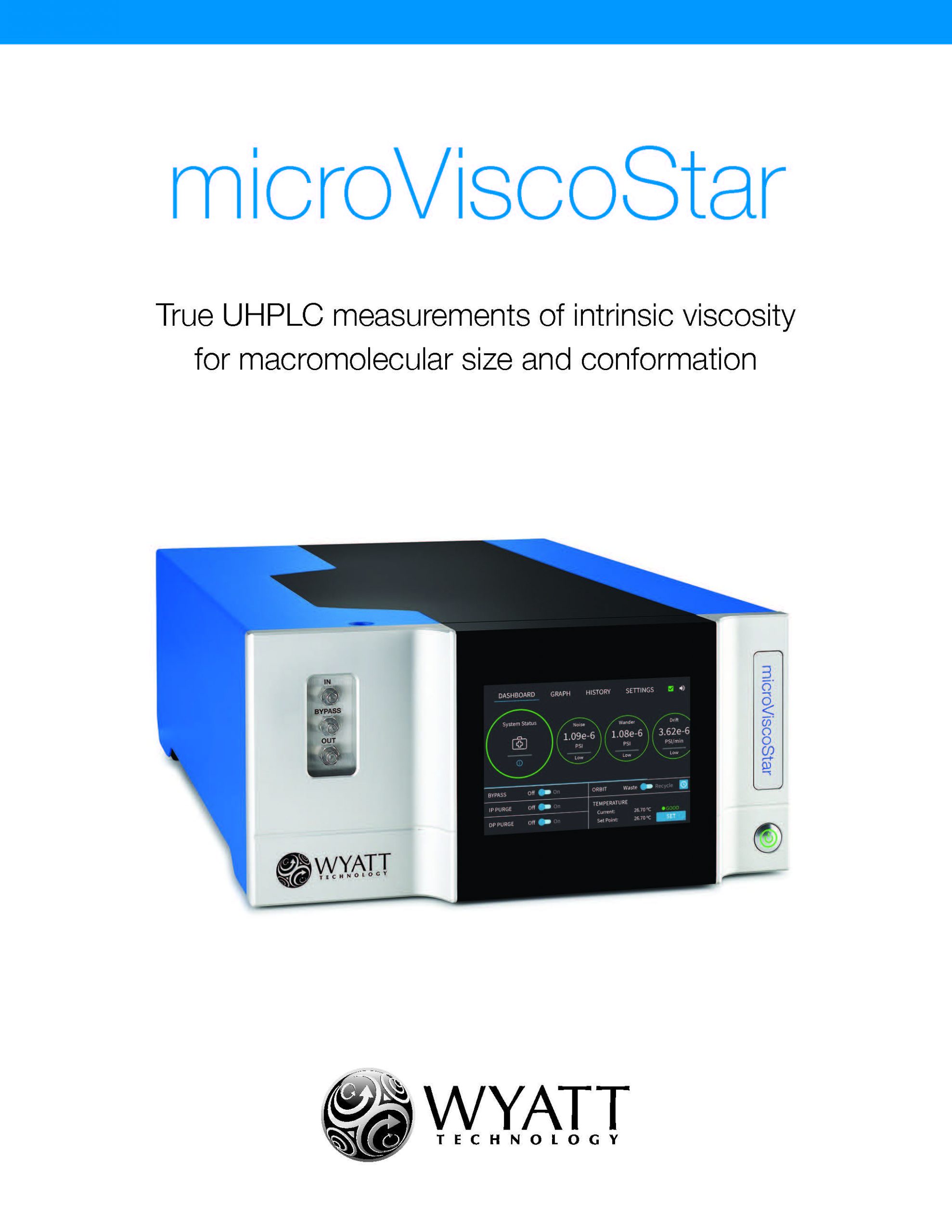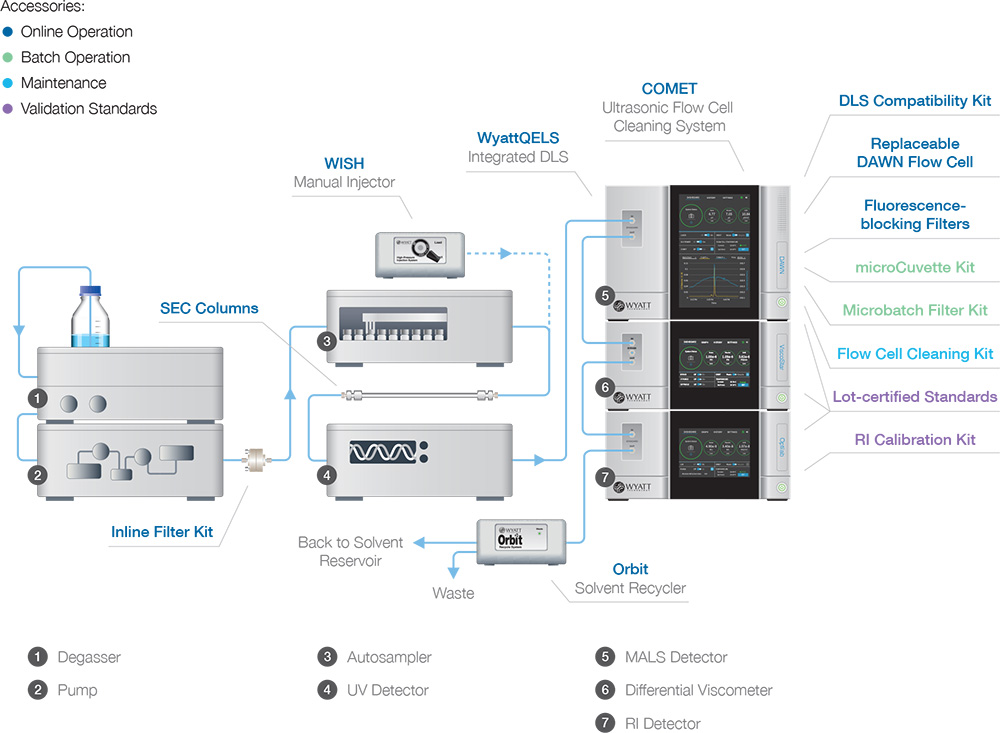microViscoStar™
Product Overview
Product Description
Brochure
Advanced Technology
On-Line Operation
Accessories
Specifications
Other Viscometers
Request Info
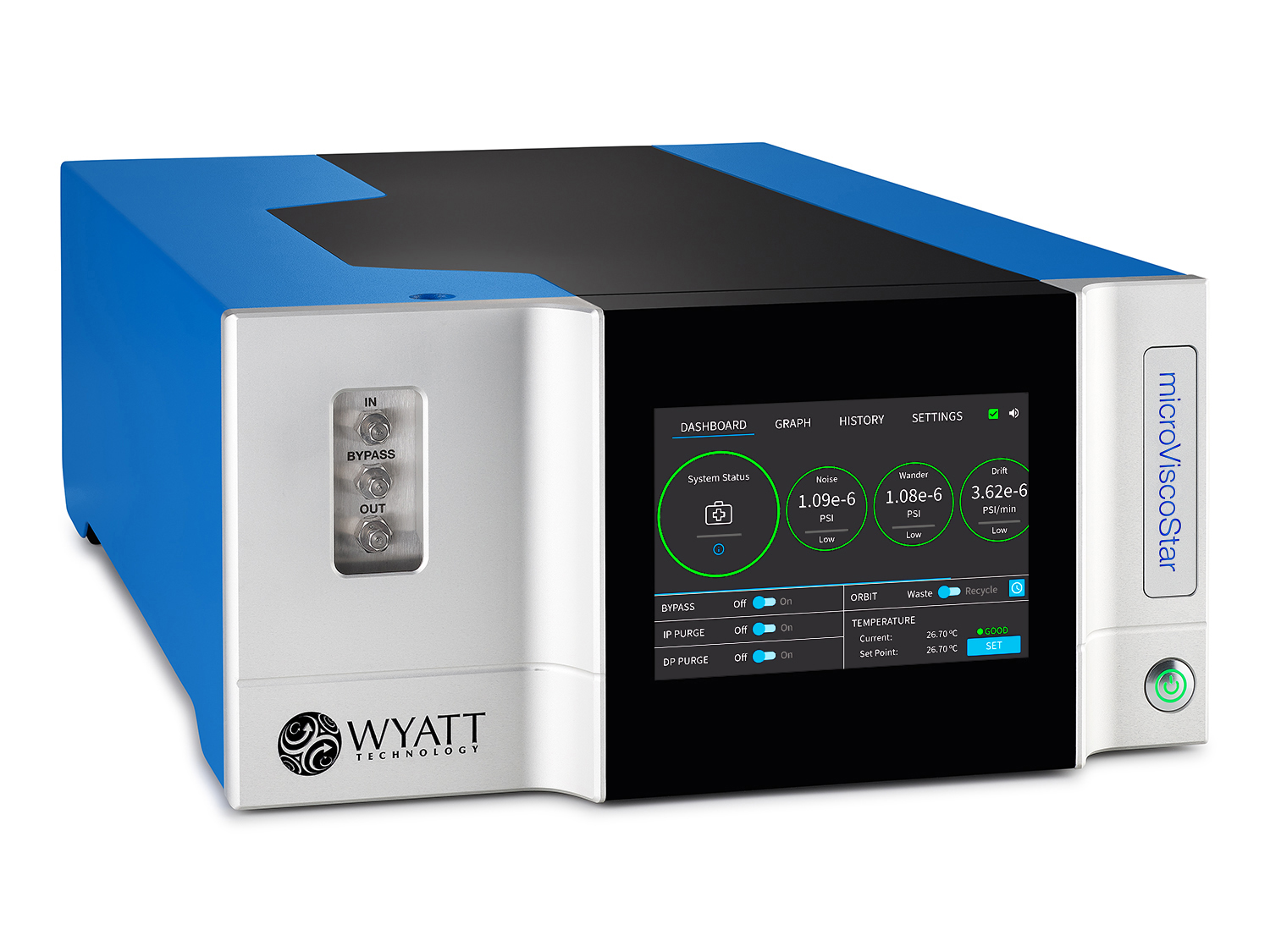
microViscoStar: Online differential viscometer for UHPLC.
Highly Sensitive
A highly sensitive, on-line differential viscometer used with SEC-MALS-IV to determine the size and conformation of polymers, proteins and peptides separated by UHPLC.
Multiple Novel Technologies
The microViscoStar™ incorporates multiple novel technologies to provide the highest sensitivity, stability and solvent compatibility of any available viscometer for UHPLC. Its ease-of-use and serviceability make it the perfect companion for Wyatt's microDAWN™ light scattering and microOptilab™ refractive index detectors for UHPLC.
APC and UHPLC Applications
View the webinar Development of a New Online Micro-Viscometer for APC and UHPLC Applications.
To learn about the technological breakthroughs implemented in the microViscoStar, download ViscoStar: Innovations in Online Viscometry for GPC.
Another path to polymer and protein characterization: SEC-MALS-IV
When coupled with UHPLC size-exclusion chromatography and a compatible concentration detector such as the Optilab™, the microViscoStar derives the intrinsic viscosity (IV) of polymers, rapidly and with minimal sample and solvent consumption. An inherently valuable physico-chemical property in itself, IV is best utilized together with molar mass information from a microDAWN multi-angle light scattering (SEC-MALS-IV) to derive the hydrodynamic radius, conformation, and branching ratio of a macromolecule in solution.
Key benefits of the microViscoStar
- High sensitivity, equivalent to 5 ng of 100 kDa polystyrene in THF at 1.0 mL/min injected onto a standard GPC column
- High dynamic range of over 135,000:1. The full measurement range corresponds to over 13 mg/mL of 100 kDa polystyrene in THF
- Extended solvent compatibility with all-316 stainless steel transducers
- Temperature range from 4 °C to 70 °C for polymers or proteins that require a range of temperatures
- Minimal band broadening thanks to fast pressure transducers
- Pump pulse suppression to below 4 Pa (hardware alone) or 1 Pa (hardware + software) without loss of chromatographic resolution
- Automated capillary bridge tuning with no moving parts, to guarantee a perfectly balanced bridge, every run
- Enhanced thermal stability with drift of <1.25 Pa/hour
SEC-IV without MALS?
Yes, as much as we love MALS for optimal polymer analysis, it's true that there are occasions when it just won't fit the bill.
Universal calibration is a parallel technique to SEC-MALS for determining molecular weight, commonly used to characterize linear polymers. While universal calibration overcomes some of the problematic issues associated with column calibration by reference molecules, it does not account for non-ideal column behavior caused by chemical solute-column interactions or hyperbranching.
Universal calibration is particularly-well suited to replace MALS for:
- Strongly fluorescent polymers
- Weakly-scattering polymer/solvent systems with very low dn/dc values
The Mark-Houwink-Sakurada relationship makes use of empirical relationships between intrinsic viscosity and molar mass, specific to each polymer and solvent, to estimate molar mass from SEC-IV measurements. Of course, the best way to determine MHS coefficients is to measure them using SEC-MALS-IV and ASTRA!
Go to the Advanced Technology tab to learn more about the unique features of the microViscoStar.
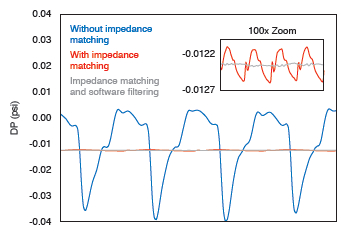
Patented pulse compensation technology in the microViscoStar eliminates pump fluctuations. At the hardware level, the bridge is impedance-matched for dynamic balance, greatly reducing the effect of pump pulses. An additional layer of software filtering eliminates residual pump pulses.
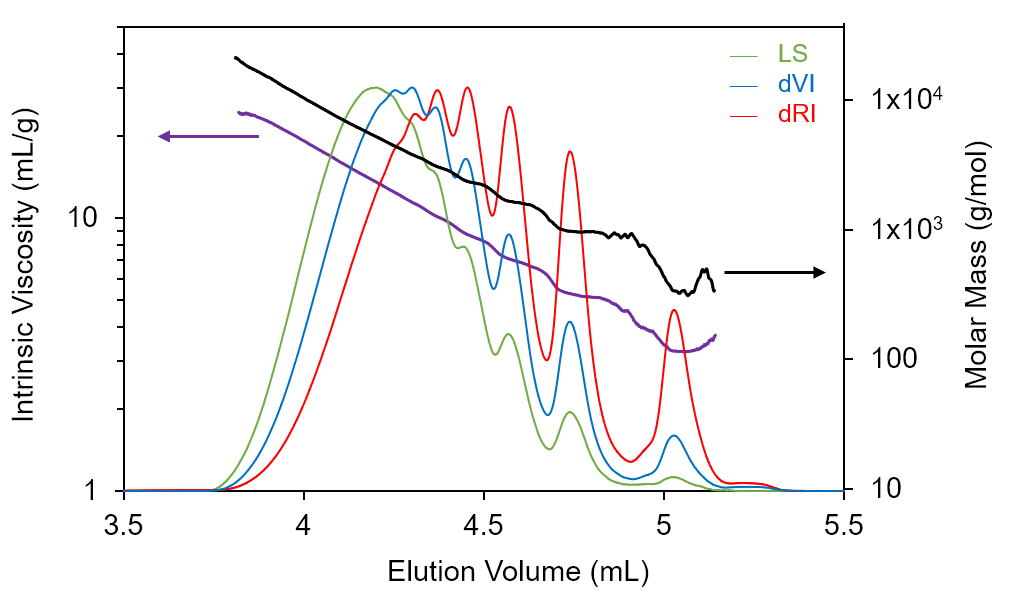
The microVisoStar maintains the narrow peaks and excellent resolution of UHPLC with maximum sensitivity. In this graph, the refractive index and specific viscosity chromatograms of an epoxy resin are overlaid with the molar mass and intrinsic viscosity results calculated from MALS and specific viscosity data, respectively, at each elution volume. The sample was separated on four Waters® APC XT columns in series with pore sizes of 45, 125, 450 and 900 Å.
True UHPLC measurements of intrinsic viscosity for macromolecular size and conformation
Click here to request a copy of our microViscoStar brochure.
Innovations in the microViscoStar
Exquisite sensitivity, stability and robustness require more than just incrementally better engineering. They are made possible by the innovative research and development carried out in Wyatt Technology's R&D center. Here are the primary innovations incorporated in this instrument:
Thermal bridge tuning - The four arms of the bridge must be perfectly balanced in order to make the most sensitive measurements. And yet accumulation of dirt or sample on the capillary walls can skew the balance set during production. Thermal bridge tuning in the microViscoStar accomplishes this balance quickly and robustly, without sliding seals or other mechanical means, guaranteeing perfect balance every run.
Pump pulse compensation - Even a well-balanced bridge is inherently susceptible to systematic noise due to dynamic pressure pulses generated by the chromatography pump. Complete impedance matching symmetrizes the dynamic properties of the capillary bridge and suppresses pump pulses in the DP transducer by 100x. And the microViscoStar does it without introducing the artificial band broadening that is used by other online viscometers to smear out pump pulses at the cost of reduced chromatographic resolution.
Pump pulse elimination - ASTRA™ implements a unique algorithm for calculating intrinsic viscosity from the IP and DP transducers that eliminates the contribution of pump pulses in the IP transducer. An additional, proprietary software filter eliminates residual DP pump pulse levels without any loss of resolution.
Dual-Peltier thermal control - Wyatt's microViscoStar is the only online viscometer for UHPLC that offers heating and cooling of the sample via Peltier-based temperature regulation. The microViscoStar takes it one step further with dual-Peltier control that eliminates internal temperature gradients, bringing signal drift down to just 2.5 Pa, 50x less than competing instruments.
System pressure protection - The highly sensitive pressure transducers utilized in the microViscoStar must be protected from overpressure due to high flow rates and/or tubing clogs which might occur in the instrument, or even in downstream instruments. The microViscoStar incorporates active protection with a system pressure sensor and bypass valve. Besides offering full protection, this arrangement has the added benefit of providing a positive warning to the user and data logging of protection activation.
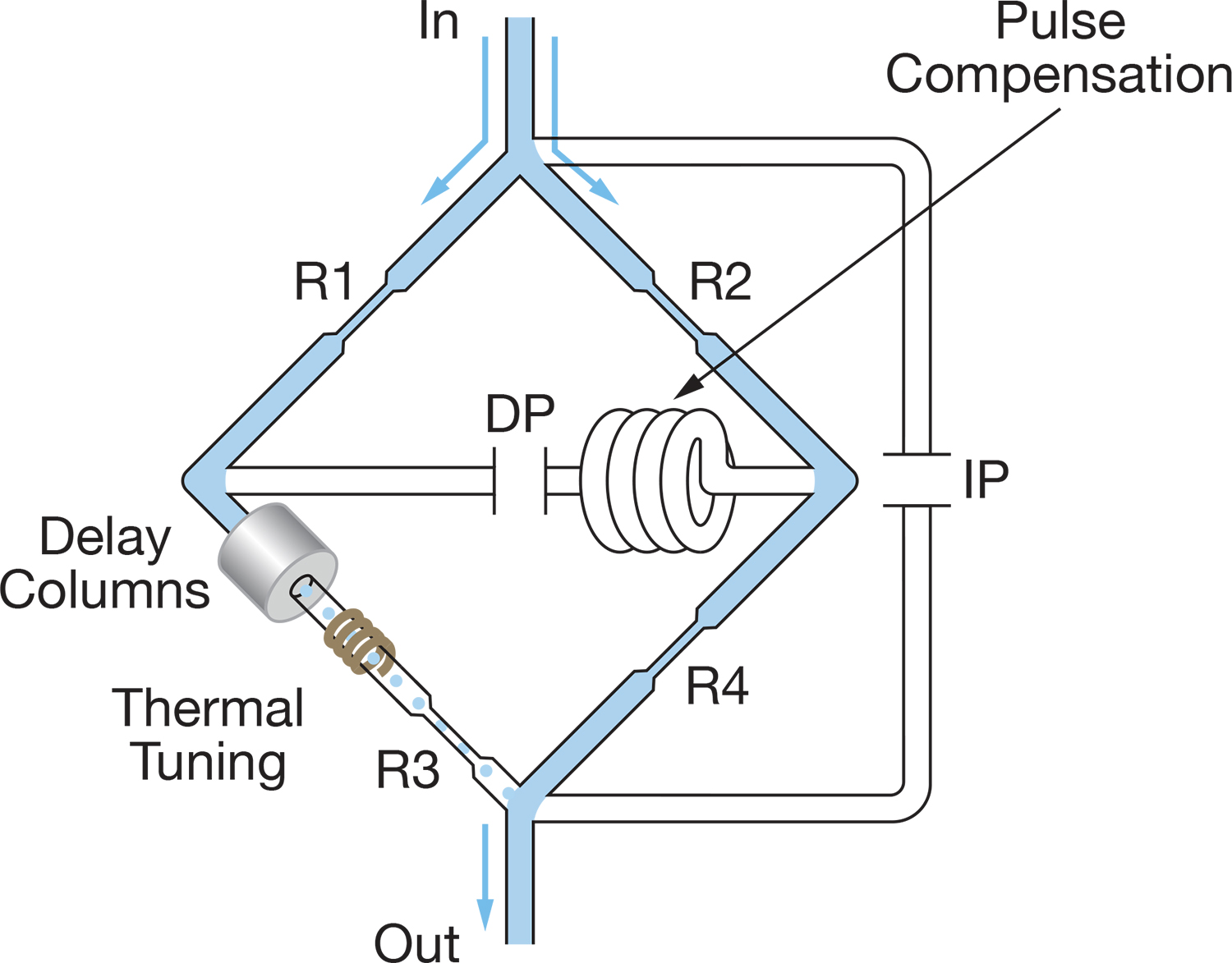
Without delay columns, the impedance of the capillary bridge would be fully balanced. The pulse compensation element matches the additional impedance of the delay columns, eliminating the dynamic effect of pump pulses on the DP transducer. Thermal bridge tuning further improves measurements by guaranteeing a perfectly balanced bridge with every run.
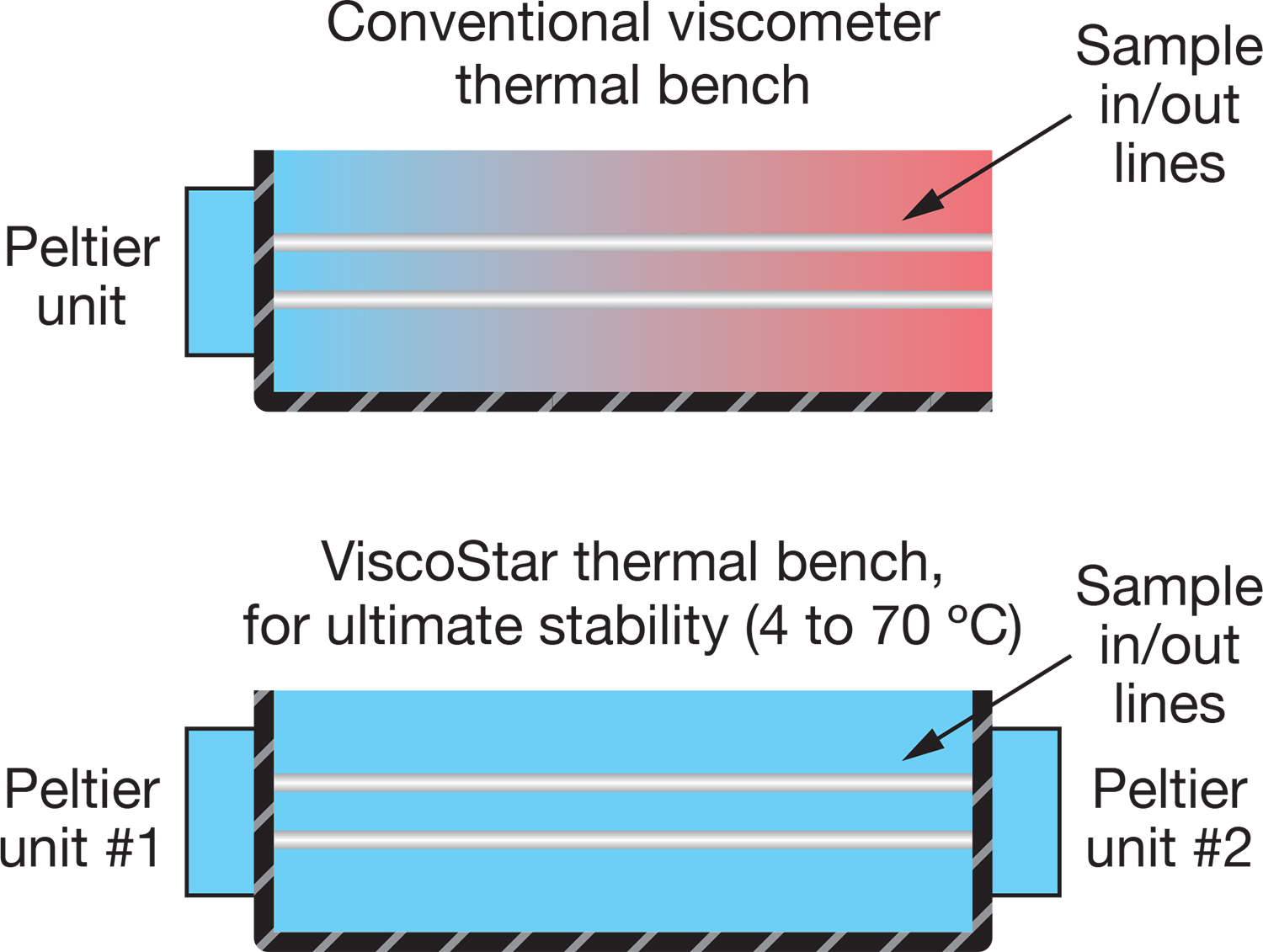
A dual-Peltier design eliminates internal temperature gradients, improving stability while enhancing the bridge's isolation from the adverse effects of room-temperature variations.
Viscometry-only
The microViscoStar may be used with any* UHPLC-SEC system, including Waters Acquity APC™, as long as the sample does not need to be heated above 70 °C in order to flow through 0.005" (0.125 mm) i.d. tubing. Combine with an Optilab for the concentration measurements needed in viscometry calculations.
ASTRA supports Universal Calibration as well as molar mass determination using Mark-Houwink-Sakurada coefficients.
SEC-MALS-IV
Combine the microViscoStar with a microDAWN™ MALS detector for an even more versatile combination that can determine Mark-Houwink-Sakurada parameters and other measures of conformation and stability. ASTRA handles all the calculations you need for full characterization of your polymers.
*Certain UHPLC pumps or injectors generate pressure pulses that can interfere with sensitive differential viscosity measurements. While the microViscoStar overcomes most of these, it is always best to start with a pulsation-free pump. Contact Us for information on optimal UHPLC systems.
| Differential Viscosity | |
| Sensitivity (minimum detectable sample) | 5 ng of 100 kDa polystyrene in THF at 1 mL/min, under typical UHPLC-SEC conditions |
| Differential pressure noise | < 0.05 Pa |
| Differential pressure range | 6.9 kPa, protected against overpressure |
| Dynamic range | 135,000:1 |
| Linearity | 0.5% of full scale |
| Differential pressure drift | < 1.25 Pa/hr |
| Capillary bridge autobalance | Thermal, leak-free mechanism |
| Sample shear rate | 15000 Hz with water at 1 mL/min |
| Fluidics | |
| Max. flow rate | Aqueous: 1 mL/min; THF: 1 mL/min1 |
| Delay volume options | 5.4 mL |
| Max. permissible pressure inlet to outlet | 3000 kPa (435 psi) |
| Wetted Materials | 316 stainless steel, PTFE, zirconium silicate, Kalrez®, Inconel, 26-1 Stainless Steel, Nickel2 |
| Temperature Control | |
| Range | 4 °C to 70 °C |
| Stability | <0.005°C |
| Ambient Range | 0 ºC to 40 ºC, 20% to 70% RH |
| Electronics | |
| Digital Output | 20 bits @ 10 Hz |
| Auxiliary I/O | |
| Inputs | Autoinject contact closure, Alarm In, Analog In: 2 differential inputs, 16 bits resolution, range -10 V to +10 V |
| Outputs | Autoinject Retransmit, Alarm Out, Recycle Out |
| On-board Computer | |
| Communications | Ethernet |
| Front Panel Display | 7" (178 mm), high-resolution, multi-touch display for viewing/setting signals, instrument settings and diagnostics. |
| Dimensions | 60 cm (L) x 36 cm (W) x 17 cm (H) |
1 Addition of an inline UV detector may impose a lower maximum flow rate.
2 Due to the location of the wetted materials on the microViscoStar detector, it is suspectable to corrosion when using buffers with high ionic strength. It is primarily recommended for use with organic solvents.
Host PC requirements may be found in Computer Requirements.
Specifications subject to change without notice.
Other Viscometers
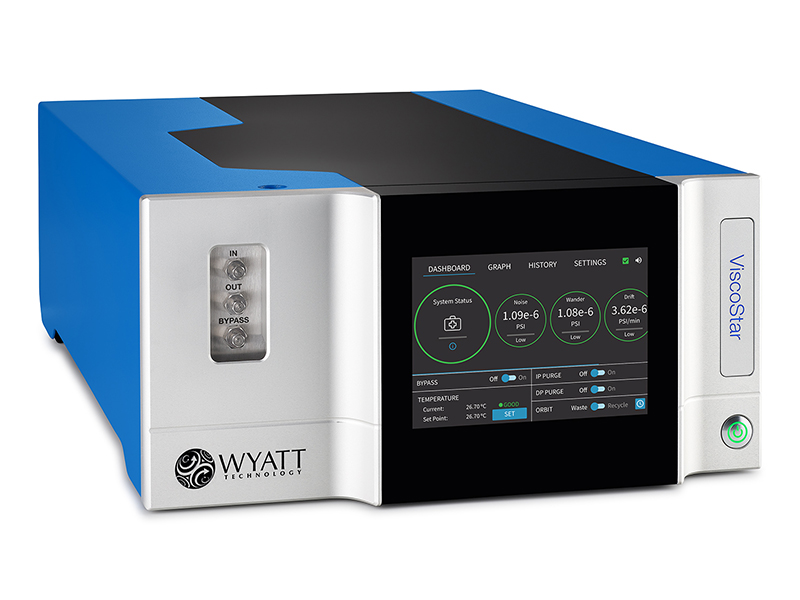
ViscoStar™ - A highly sensitive, on-line differential viscometer used in conjunction with SEC-MALS to determine the size and conformation of all types of biopolymers, synthetic polymers and even proteins and peptides.
The ViscoStar incorporates multiple novel technologies to provide the highest sensitivity, stability and solvent compatibility of any available viscometer for GPC. Its ease-of-use and serviceability make it the perfect companion for Wyatt's DAWN® light scattering and Optilab® refractive index detectors. Temperature-controlled from 4 °C to 70 °C .

